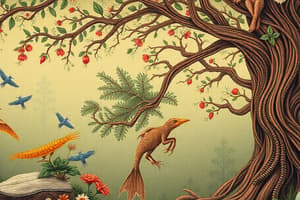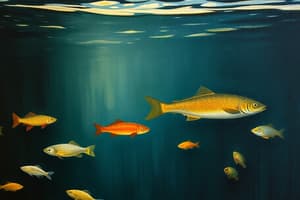Podcast
Questions and Answers
What is the role of producers in a food chain?
What is the role of producers in a food chain?
- Feed on plants
- Convert sunlight into energy through photosynthesis (correct)
- Are primary consumers
- Feed on herbivores
Which organisms are considered tertiary consumers in a food chain?
Which organisms are considered tertiary consumers in a food chain?
- Secondary consumers
- Herbivores
- Producers
- Top predators (correct)
What do herbivores primarily feed on in a food chain?
What do herbivores primarily feed on in a food chain?
- Secondary consumers
- Omnivores
- Carnivores
- Producers (correct)
In a food chain, what is the function of carnivores and omnivores?
In a food chain, what is the function of carnivores and omnivores?
Which trophic level do carnivores and omnivores occupy in a food chain?
Which trophic level do carnivores and omnivores occupy in a food chain?
What is the significance of trophic levels in a food web?
What is the significance of trophic levels in a food web?
What is one reason why food chains are not 100% efficient?
What is one reason why food chains are not 100% efficient?
How do changes in one part of a food chain affect the ecosystem?
How do changes in one part of a food chain affect the ecosystem?
Which statement best explains why food chains are essential for ecosystems?
Which statement best explains why food chains are essential for ecosystems?
What role does a primary consumer play in a food chain?
What role does a primary consumer play in a food chain?
How can an increase in the population of a primary consumer impact the ecosystem?
How can an increase in the population of a primary consumer impact the ecosystem?
Why is understanding food chains crucial for comprehending ecosystems?
Why is understanding food chains crucial for comprehending ecosystems?
Flashcards are hidden until you start studying
Study Notes
An In-depth Look at Ecosystems: Understanding Food Chains
Food chains play a crucial role in ecosystems. They represent the flow of energy and nutrients between different species in an ecological community. Here is an in-depth look at the concept of ecosystems, particularly focusing on food chains.
Ecosystems
An ecosystem is a community of living organisms interacting with each other and their physical environment. It is a dynamic and complex network of relationships between different species and their physical surroundings. Ecosystems can be found at various scales, from a puddle of water to an entire forest.
Food Chains
Food chains are a simplified way to understand how energy and nutrients flow through an ecosystem. They show the transfer of energy from one organism to another. The process starts with a producer, usually a plant, which converts sunlight into energy through photosynthesis. Herbivores, or primary consumers, feed on the plants. Secondary consumers, such as carnivores or omnivores, feed on the herbivores. Finally, tertiary consumers, like top predators, feed on the secondary consumers.
Trophic Levels
Each organism in a food chain occupies a specific trophic level. Producers are at the first level, herbivores at the second level, carnivores and omnivores at the third level, and top predators at the fourth level. This hierarchy is known as a food web, as it shows the many different relationships between species.
Food Chain Efficiency
Food chains are not 100% efficient. Some energy is lost at each trophic level, due to factors such as incomplete digestion or excretion. For example, a herbivore may eat a plant, but not all of the energy stored in that plant will be transferred to the herbivore. Some energy will be lost as heat or metabolic waste.
Food Chain Dynamics
Food chains are dynamic systems. Changes in one part of the chain can have ripple effects throughout the ecosystem. For example, if the population of a primary consumer increases, it may lead to a decrease in the population of its food source. This, in turn, may impact the population of secondary consumers that feed on the primary consumer.
Food Chain and Ecosystem Services
Food chains are an integral part of the ecosystem services provided by ecosystems. Ecosystem services are the benefits people obtain from ecosystems, such as food, water, and clean air. A healthy food chain ensures the availability of these services.
Conclusion
Understanding food chains is essential for understanding ecosystems. They show how energy and nutrients flow through an ecosystem, and how different species interact with each other. By studying food chains, we can gain valuable insights into the complex dynamics of ecosystems and the services they provide.
Studying That Suits You
Use AI to generate personalized quizzes and flashcards to suit your learning preferences.




